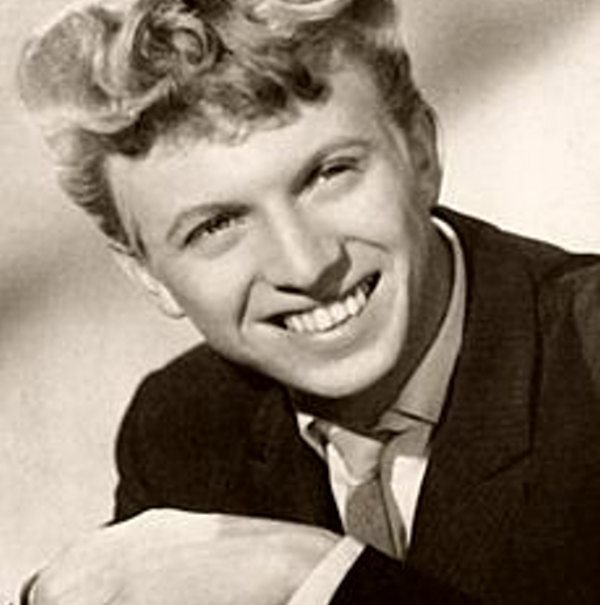TOMMY STEELE

Biography
Before landing a singing career, Tommy Steele tried his hand at a number of odd jobs and had a brief spell as a merchant seaman. Like many singers of his era he never did national service, having failed the medical examination because, at eighteen years old, he was diagnosed as suffering with cardiomyopathy. However, according to his autobiography, Bermondsey Boy: Memories of a Forgotten World, he failed the medical because he had flat feet. While on leave or during dock strikes, he played guitar and banjo and sang in The 2i’s Coffee Bar and the Cat’s Whisker where hand-jiving was devised, two coffee houses in Soho, both as a solo performer and with Wally Whyton’s Vipers Skiffle Group.
When a ship Tommy Steele was serving on docked in Norfolk, Virginia, he heard Buddy Holly and fell in love with rock and roll, turning his back on the British skiffle craze. He was discovered by freelance photographer John Kennedy, who believed Steele could be Britain’s answer to Elvis Presley. Later co-manager Larry Parnes was incorrectly credited with creating the stage name ‘Tommy Steele.’ It was Steele who adapted the surname of his Scandinavian paternal grandfather, Thomas Stil-Hicks (pronounced Steel-Hicks), adding another E to the spelling.
Tommy Steele shot quickly to fame in the UK as the frontman for a rock and roll band, the Steelmen, after their first single, “Rock With The Caveman,” reached number 13 in the UK Singles Chart in 1956. Steele and other British singers would pick known hit records from the United States, record their cover versions of these songs, and release them in the UK before the American versions could enter the charts. Most of Steele’s 1950s recordings were covers of American hits, such as “Singing the Blues” and “Knee Deep in the Blues”. Although Steele never proved a serious threat to Presley’s popularity in the UK, he did well on the 1950s UK chart and “Singing the Blues” got to Number 1 in the UK before Presley did so. Guy Mitchell was number 1 with “Singing the Blues” on 4 January 1957 and Tommy Steele on 11 January 1957. Steele’s 1957 album, The Tommy Steele Story, was the first by a UK-based act to reach #1 in the UK.
The increase in home-grown musical talent during the 1960s allowed Steele to progress to a career in stage and film musicals, leaving behind his pop idol identity. In the West End he appeared in She Stoops to Conquer and played the title role of Hans Christian Andersen. On film, he recreated his London and Broadway stage role in Half A Sixpence, and played character roles in The Happiest Millionaire and Finian’s Rainbow, although many critics found his personality to be somewhat overwhelming on screen. In this latter film, probably his best known appearance in the films, he played Og, the leprechaun turning human, and co-starred with Petula Clark and Fred Astaire. In 1968 British exhibitors voted him the fourth most popular star at the local box office.
In April 1971, Steele starred in his own show Meet Me in London at London’s Adelphi Theatre.
In 1983, Tommy Steele directed and starred in the West End stage production of Singin’ in the Rain at the London Palladium. In 1991 he toured with Some Like It Hot the stage version of the Jack Lemmon and Marilyn Monroe film.
Tommy Steele was born in Bermondsey, London. He married Ann Donoghue at St. Patrick’s Catholic Church, Soho Square, London, in 1960. They have one daughter, Emma.
In the early 1980s, Steele wrote and published a book titled The Final Run, a novel about World War II and the evacuation of Dunkirk.
Steele is mentioned briefly in Ian Fleming’s James Bond novel, Thunderball. Evidently Fleming viewed Steele as a teen idol of the entitled post-war youth, existing in a modern world alongside atomic bombs, space flight and the Welfare State.
Steele’s autobiography was published in September 2006 and is entitled Bermondsey Boy: Memories of a Forgotten World (London: Joseph) ISBN 0-7181-4972-6
Tommy Steele co-wrote many of his early songs with Lionel Bart and Mike Pratt, but he used the pseudonym of Jimmy Bennett from 1958 onwards.
For many years it was thought that Elvis Presley had never set foot in England, and had only ever spent a few minutes on the tarmac at Prestwick Airport in Scotland where his military plane, en route to the United States after completing his army service in West Germany, stopped to re-fuel. However, on 21 April 2008, in a BBC Radio 2 interview with theatre impresario Bill Kenwright, it was claimed that Presley, then 23, had visited England for a day, after a phone conversation with Steele in London in 1958. According to Kenwright: “Elvis flew in for a day and Tommy showed him round London. He showed him the Houses of Parliament and spent the day with him”. Kenwright admitted on 22 April 2008 that he was not sure whether he should have told the story. Tommy Steele said: “It was two young men sharing the same love of their music. I swore never to divulge publicly what took place and I regret that it has found some way of getting into the light. I only hope he can forgive me.”
Press officers employed by Stagecoach, the company that owns Prestwick Airport, rapidly issued a statement requesting proof, photographic or otherwise, of the said meeting. Until such proof is provided, they will continue to describe their property Prestwick Airport as being the only place in Britain where Elvis Presley ever set foot, and will not be removing the marker, photographs and special lounge at their airport which relate to their claim.



 Tommy Steele, Tommy Steele
Tommy Steele, Tommy Steele Vintage Hits 50', Rock
Vintage Hits 50', Rock Top Hits Vintage
Top Hits Vintage Vintage Music And The Vocal Groups
Vintage Music And The Vocal Groups



